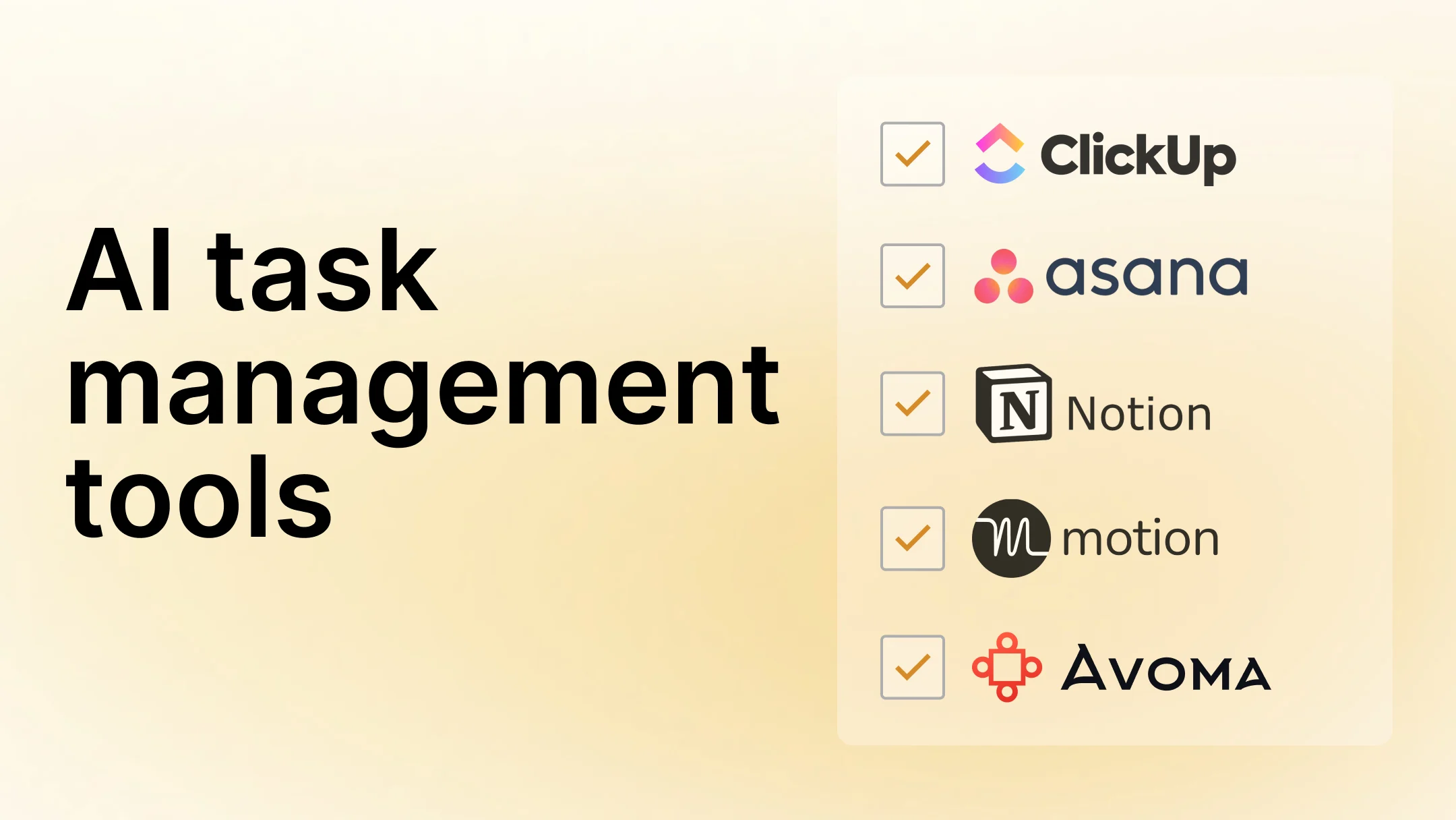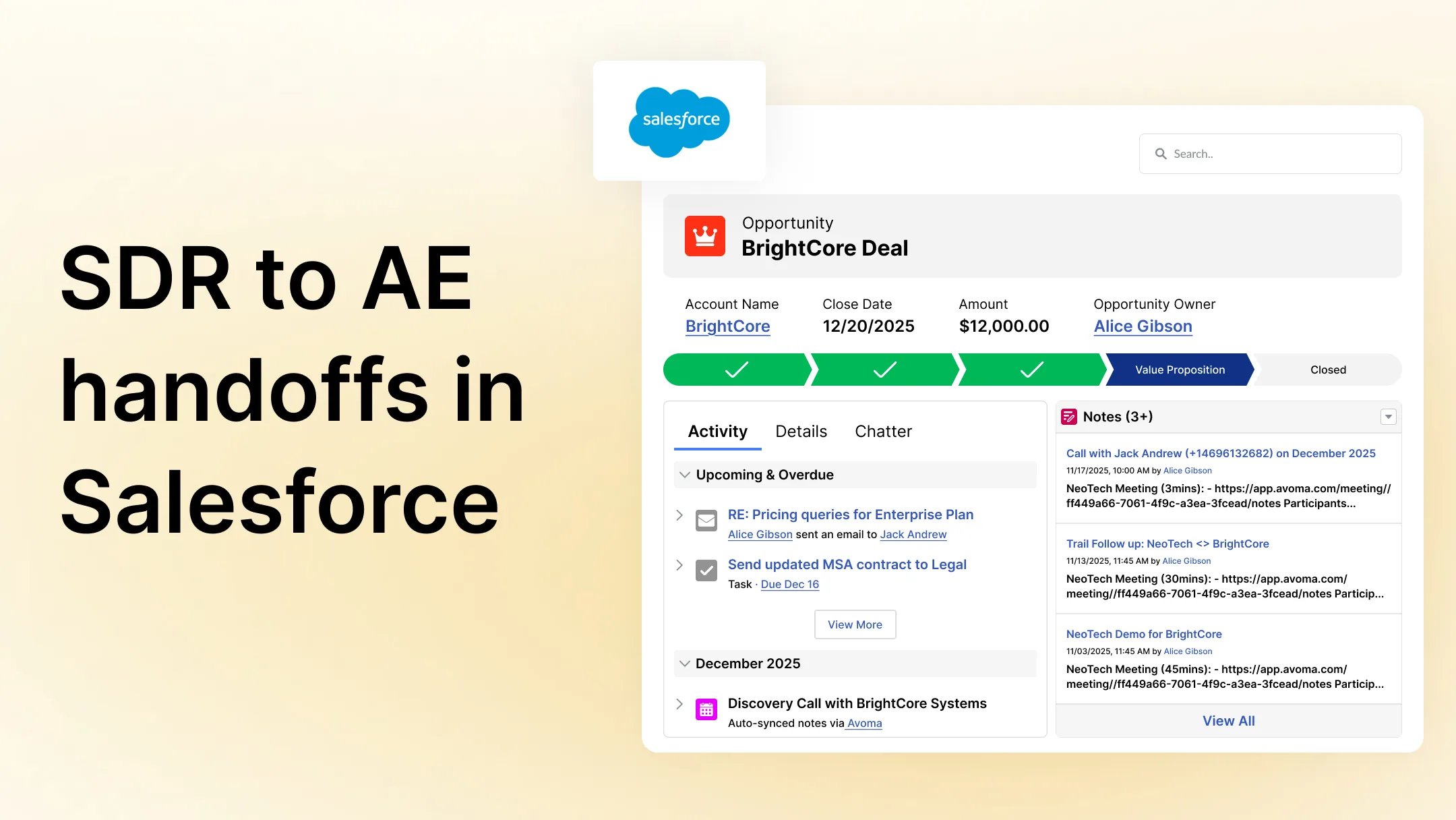What is a meeting lifecycle assistant and why do you need one?
Table of Contents:

“Starting a company is like jumping off a cliff and assembling a plane on the way down.”
This quote—from entrepreneur and author Reid Hoffman—is widely celebrated by many entrepreneurs and almost everyone else in today’s corporate world because it deeply resonates with them.
However, romanticizing this idea leads to many problems when we accept it as a norm and apply it to other aspects of running our businesses.
Take meetings, for instance. Meetings are supposed to be a vehicle for collaboration. Instead, we in the business world have made it into an ineffective improvising tool. This accidental monster gobbles up our precious time and smashes productivity into irreconcilable pieces of rubble.
Here are the stats to show the ugly sides of meetings:
- In the US alone, approximately 55 million meetings happen every single day.
- If you are a manager, you are probably meeting 12 times/week on average.
- As an individual contributor, you are likely attending eight meetings per week on average.
- We usually spend 6 hours/week (or 15% of your workweek) just planning meeting activities—and not attending the actual meetings.
That last stat, in particular, is the biggest reason why meetings are counterproductive to our time. When assembling the plane parts takes way longer, your flight mission will crash 100%. This is to say—if meetings are becoming a source of constant distraction for your organization, maybe it’s time for you to introspect and find possible solutions to the problem.
What caused meetings to become this time-suck monster? And what can we do about fixing it? Let’s find out in the next couple of sections.
Why do meetings fail?
Unfortunately, in the modern-day workplace, the meeting lifecycle is a hot mess of inefficient processes. Wasting valuable time managing meeting activities is like spending several hours commuting to a job that requires only a few hours to do the actual work.
Most meetings have a three-stage lifecycle that spans many tools and processes—namely, the activities that occur before, during, and after the meeting. If you analyze further, four specific problems contribute to the ineffectiveness of meetings as a collaborative process.

1. Context switching across different apps
A meeting is effectively a collaboration ground between different individuals and teams. And these individuals and teams use different apps to record data, manage their to-dos, or carry out workflows. But their data in these apps are exclusive to the respective people and teams because they don’t have a common roof to store or share the information.
Therefore, “meetings collaboration” is virtually non-existent because there isn’t a common thread that weaves across the different groups of people.
2. Information is lost across disparate systems
When you use a wide variety of tools to manage your everyday work, valuable information often gets lost in translation due to various reasons. For example, let’s say you use Google Calendar to schedule meetings and prefer Evernote to take notes during those meetings—two distinct tools to manage different aspects of the meeting lifecycle.
However, your colleagues—who are important stakeholders in the process—don’t have the same visibility of the data as you because they might be using their own set of tools. The tools that you use might not be connected to the tools that they use because you haven’t made the manual effort to do so. Or, both of those tools don’t play well with each other because of compatibility issues. This usually results in important information being lost in the process despite your best efforts.
3. Meetings are siloed and not collaborative
It’s ironic to realize that meetings lack collaboration, and the information that they produce is often siloed because meetings, by design, are supposed to enable collaboration. But think of all the meetings that take place in your organization, and you will quickly realize how compartmentalized they are.
The customer success team don’t know about the conversations that take place between sales and the customers, marketing is rarely invited to be a part of the user research interviews that the product team carries out, and the engineering team is completely unaware of the go-to-market (GTM) strategies that the sales, marketing, and product teams discuss among themselves.
4. Valuable time is wasted in grunt work
If we go back to the stats about how we waste 15% of our time every week managing meeting activities, it comes to an average of 30 minutes of planning activities around a single meeting.
That means you lose around six hours of your life every week doing menial tasks like scheduling, corresponding, rescheduling, or canceling meetings even before the event begins. It’s an assembly process that steals away your precious time from doing the actual work.
So what exactly are we missing?
Today, most meetings lack a system or tool that synchronizes all aspects of the meeting lifecycle in one continuous workflow and breaks down the silos between teams. Here’s how an ideal meeting lifecycle process happens in the presence of such a tool:
Before the meeting
Of course, we all use Calendar and meeting scheduling apps to invite all stakeholders to discuss, accept invitations, or reschedule events.
What’s largely missing from the meeting lifecycle today is the lack of agenda-setting. It’s not enough to let everyone know about an upcoming meeting—sharing an agenda adds value and helps everyone come prepared to the meeting table. In fact, it also helps people decide whether it makes sense for them to attend the meeting.
Yes, creating an agenda can be a taxing process for each meeting. Given that many a time, meetings are follow-ups of previous conversations or have recurring patterns—won’t it be nice to have a tool that automatically assigns the right meeting agenda template based on the purpose of your meeting?
That is exactly where shared meeting templates of Avoma help. You can create and share purpose-based meeting agenda templates across functions in your organization. And the best part is—the right meeting agenda templates automatically get assigned to your meetings based on the meeting purpose.
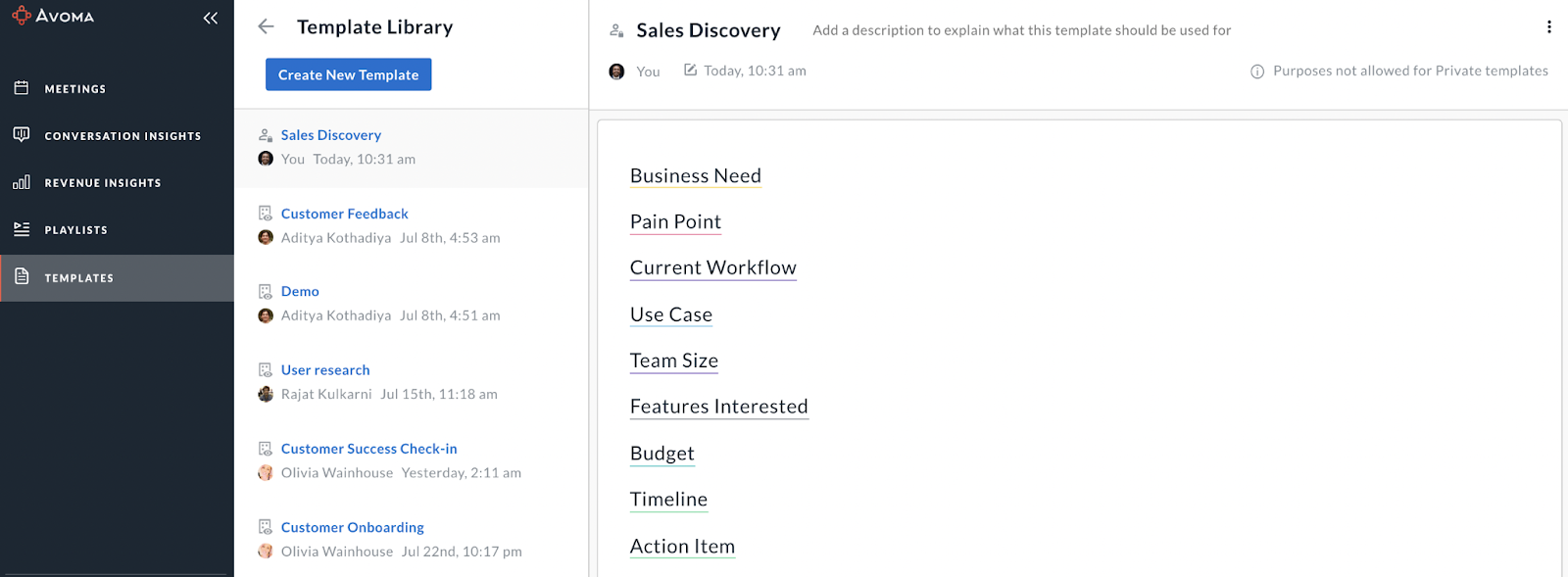
During the meeting
When meetings kickoff, most participants start taking hand-written notes or use their phones to note important points. These are low-value tasks that you can automate using AI-generated notes and real-time transcriptions. You are better off actively contributing to the meeting’s content by interacting with other participants and solving their problems.

After the meeting
This is the phase where most meetings lose value. You attend a meeting, give feedback, participate in a discussion, and invest your time and effort only to leave with no clarification on the next steps. People usually spend so much effort during the meeting, and sometimes even before the meeting, and forget that they have to close the loop.
What’s missing is a tool that can take 100% of the meeting content, analyze it and offer intelligence that helps you do better in your role. And it’s not about just one meeting, but we need a cumulative analysis and intelligence across different functional meetings happening in the organization.
For instance, instead of you assuming who your main competitors are, you could leverage the intelligence across meetings to know who your prospects compare you the most with.
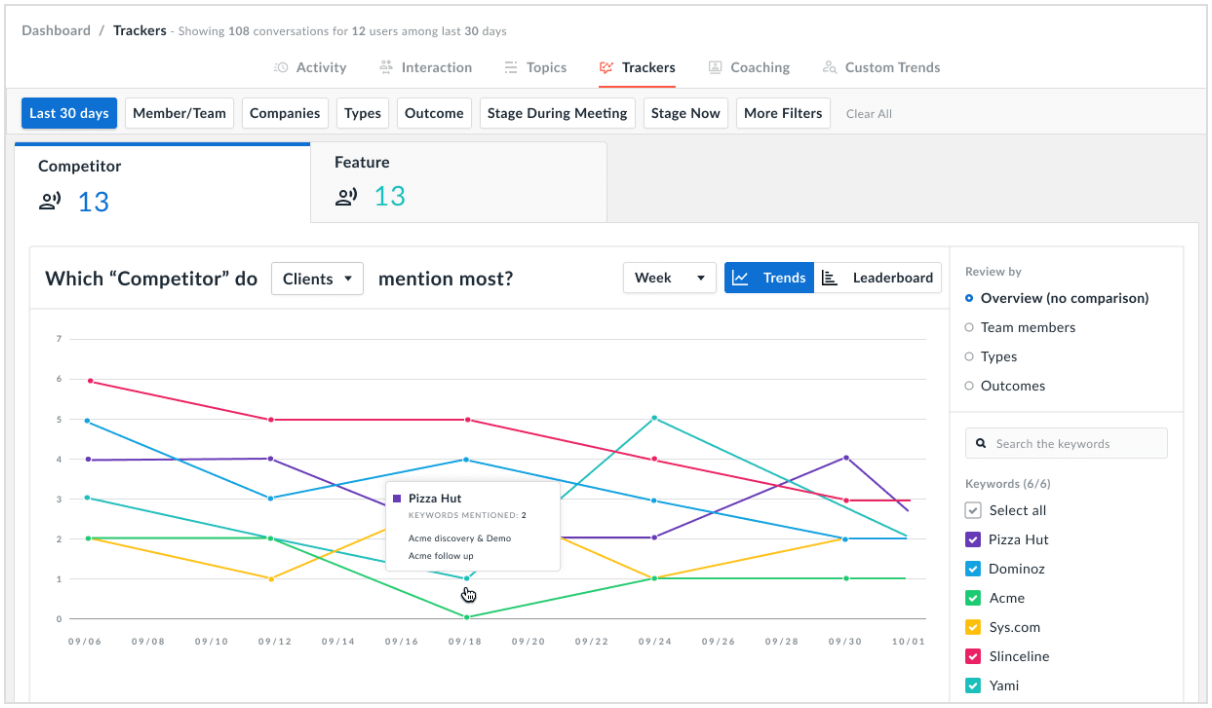
In short, to tie these different stages of the meeting lifecycle into a cohesive flow of collaboration, you need a meeting lifecycle assistant tool.
What is a meeting lifecycle assistant?
A meeting lifecycle assistant is a platform that helps you manage the entire meeting lifecycle—from scheduling your meetings to automatically taking notes during the meetings and from reducing no-shows to getting actionable intelligence from conversations across the board.
Avoma’s meeting lifecycle assistant offers a single solution for all your meeting requirements across the organization. It not only makes your meetings smarter and actionable but also helps you break workplace silos because the platform optimizes for individual and team needs.
Key components of a meeting lifecycle assistant:
- Meeting Management
- Meeting Assistant
- Meeting Collaboration
- Meeting Intelligence
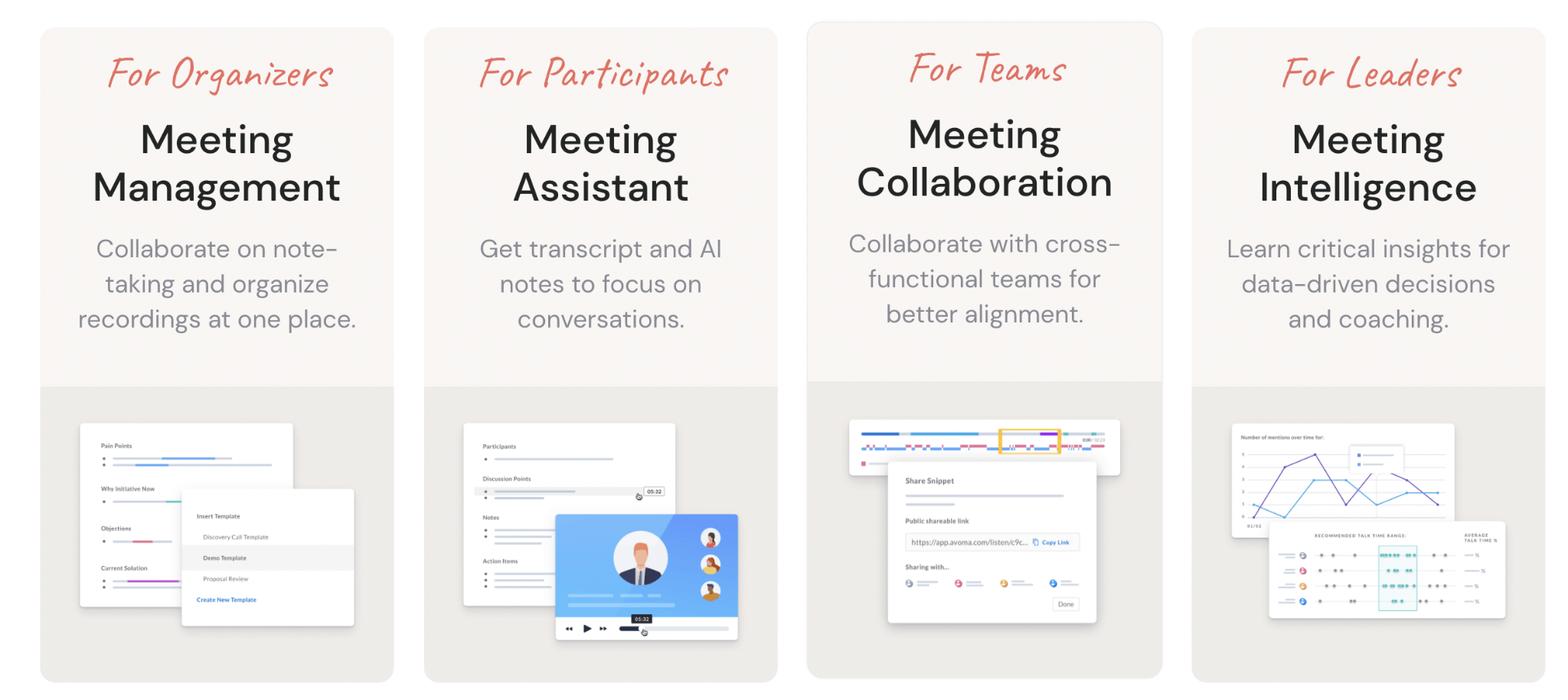
1. Meeting Management
The Meeting Management component helps you prepare, collaborate and search across all meetings in one central place. It enables you to create and share templates that get automatically assigned to your meetings, ensures that AI automatically captures meeting notes for you, and also lets you collaborate with your colleagues in real-time to take notes.

This is in stark contrast to different people using different tools to record a meeting’s content—thus, ensuring a high level of consistency and accuracy across various functions. But in case you have extra points to add to the automated notes, you or other meeting participants can augment the AI-assisted notes by simply live bookmarking during the conversation.
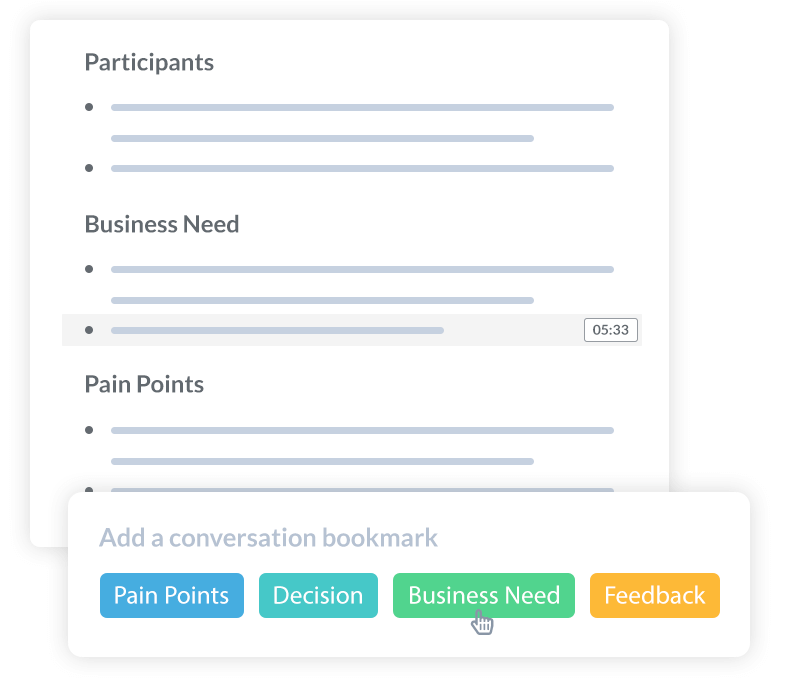
In combination, the Meeting Management component alone helps you save more than 15% of your time on managing meeting activities so that you can head right into a meeting without having to worry about slogging through the low-value administrative tasks or becoming distracted with manual tasks during a meeting.
2. Meeting Assistant
Active listening is a key element of any conversation, especially when talking to customers or discussing complex topics with colleagues from another team. Taking shorthand notes not only impacts actively listening to what’s being discussed during meetings, it even results in awkward pauses at times.
This is where the AI Meeting Assistant component comes into play. It helps you automatically record the audio and video content of the meeting and transcribe it into easily scannable text that you can refer to in the future.
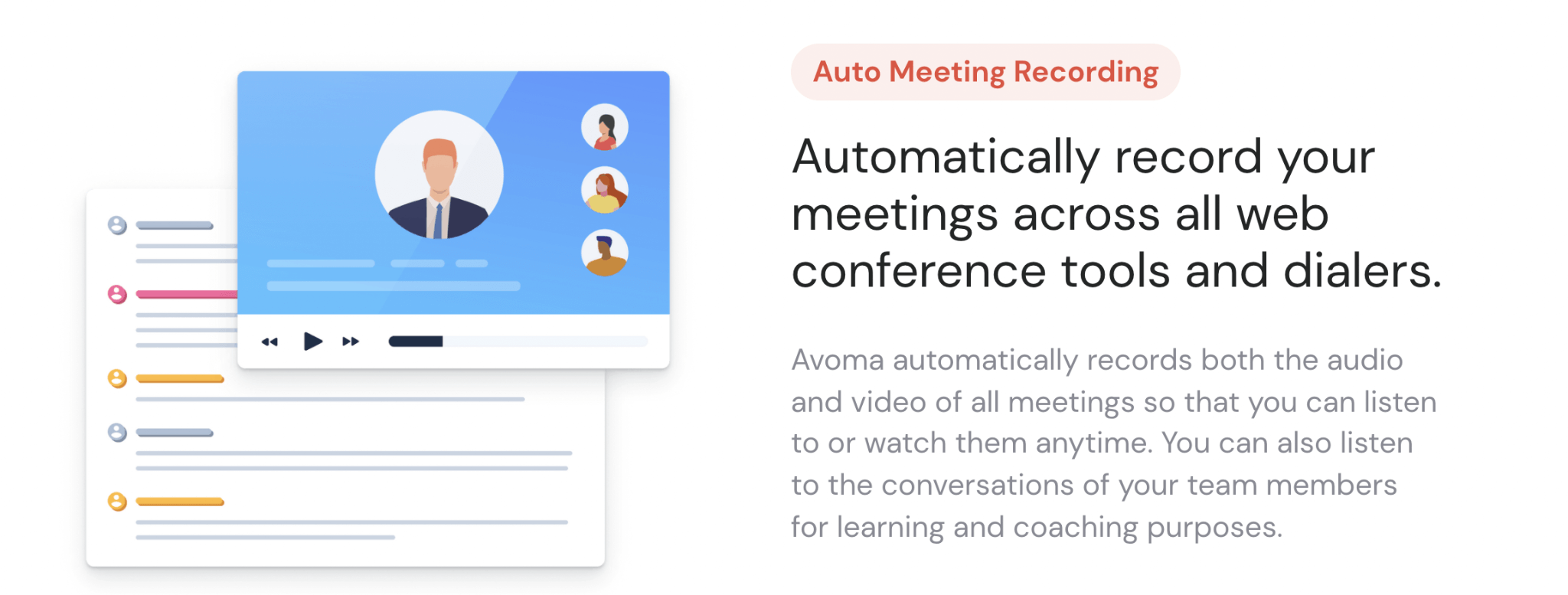
Avoma is the only platform that offers summarized notes for every meeting/call in addition to the transcription, which also automatically syncs to your CRM notes. In addition, it identifies the different speakers in the conversation; timestamps key every conversation and links to the video recording and more.
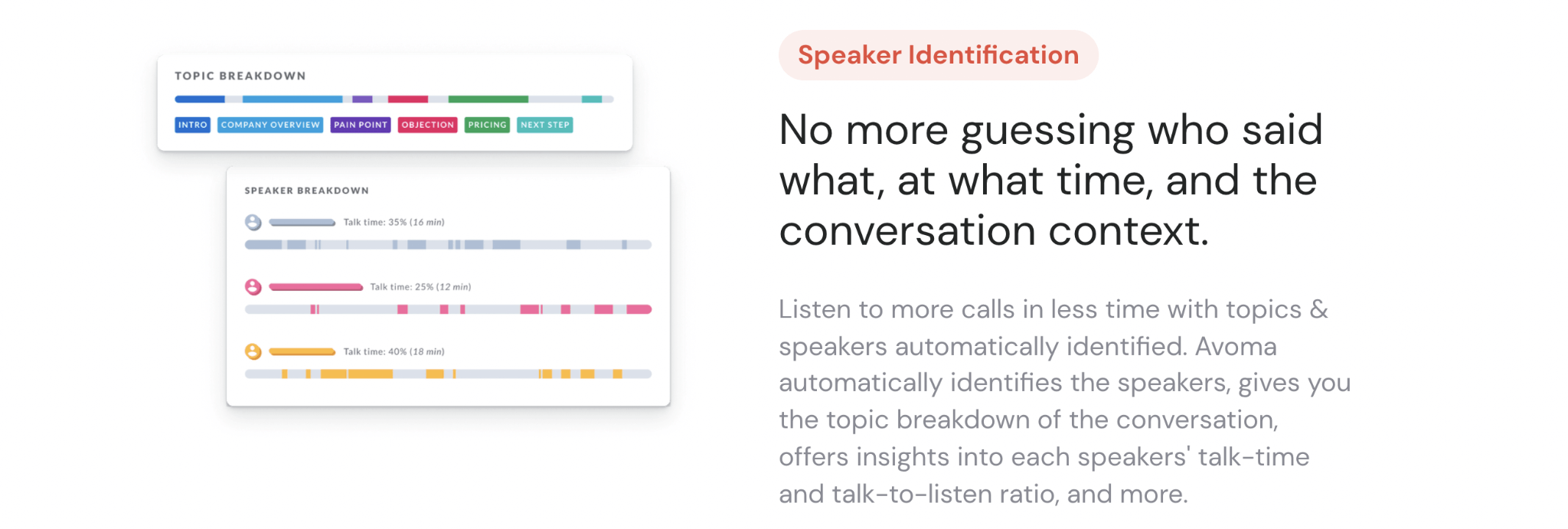
3. Meeting Collaboration
Scanning, searching, sharing information, and offering feedback loops are some of the key components of an efficient meeting lifecycle assistant. To that end, Avoma’s Meeting Collaboration component provides a powerful ‘Search’ feature to help you leverage all your meetings by making it a searchable knowledge base.
You can also save your search queries by keywords to filter out relevant conversations so that you don’t have to manually look up information when you need it.
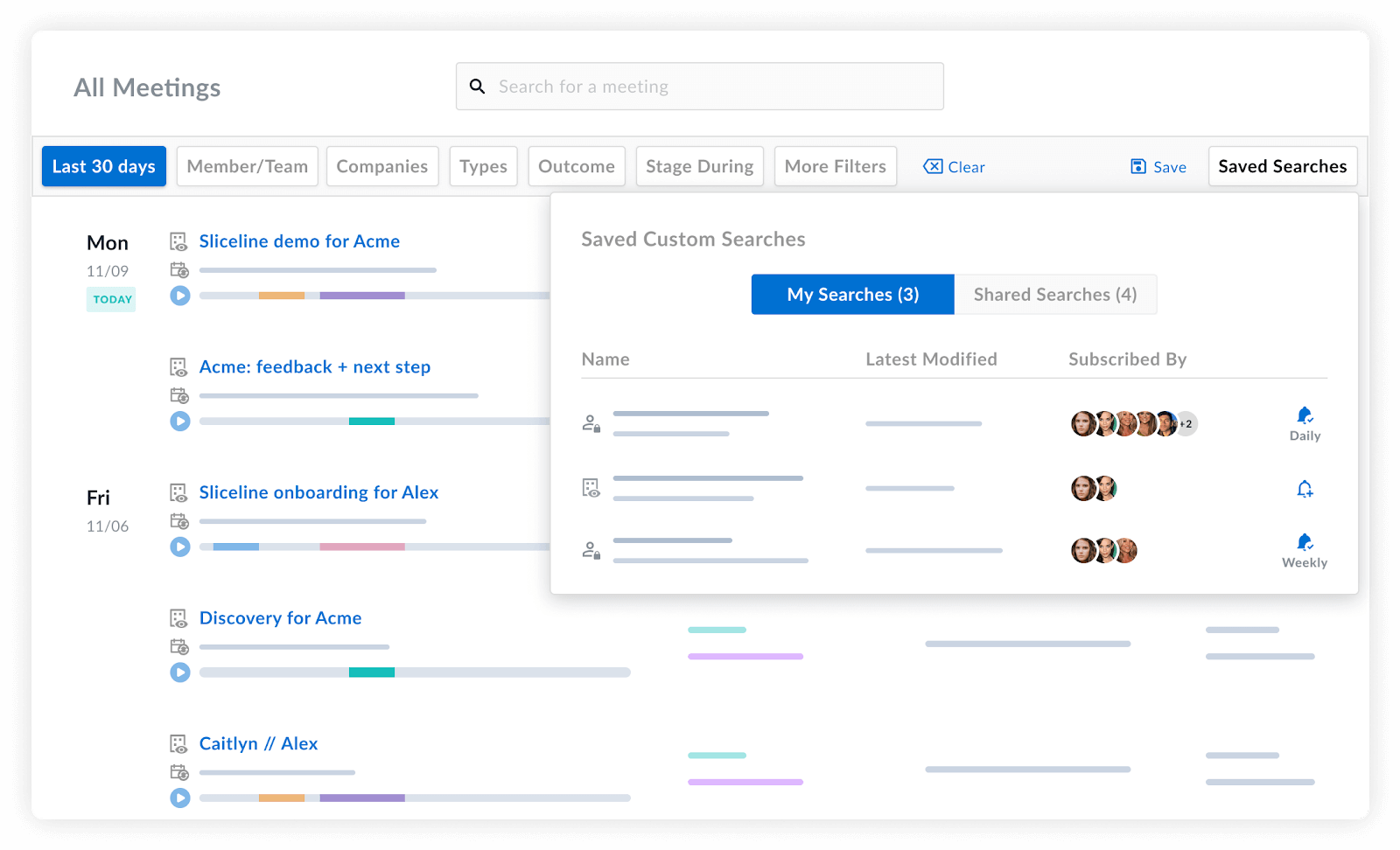
Another key aspect under Meeting Collaboration is commenting on specific parts of recorded conversations either to tighten collaboration between teams or to exchange coaching-related feedback. You can ask questions, offer feedback, brainstorm on ideas, and make decisions—all in the same place.

Avoma’s Meeting Collaboration also offers Playlists as another tool to facilitate self-paced learning and coaching. You can create new Playlists in Avoma, add several recordings or snippets of conversations to your playlists, and start listening to them at your convenience. Honestly, this is as simple and self-explanatory as building your personal music playlists in Spotify. You can create, edit, and share multiple playlists as you need.
4. Meeting Intelligence
Meeting Intelligence is one of the most critical components of the meeting lifecycle assistant. This component helps you mine meaningful insights out of raw data, synthesizing them into actionable decisions.
For example, imagine your product needs data to prioritize and build a set of features from their roadmap. A simple look into the conversation trackers would give them the leaderboard of the features most requested by customers.

Similarly, your salespeople can improve their communication by looking at their most used filler words, including the number of times they use them during a conversation. Or they can look at the trackers of successful reps across the company and understand the parts of the conversation they spend the most time on and learn from those patterns.
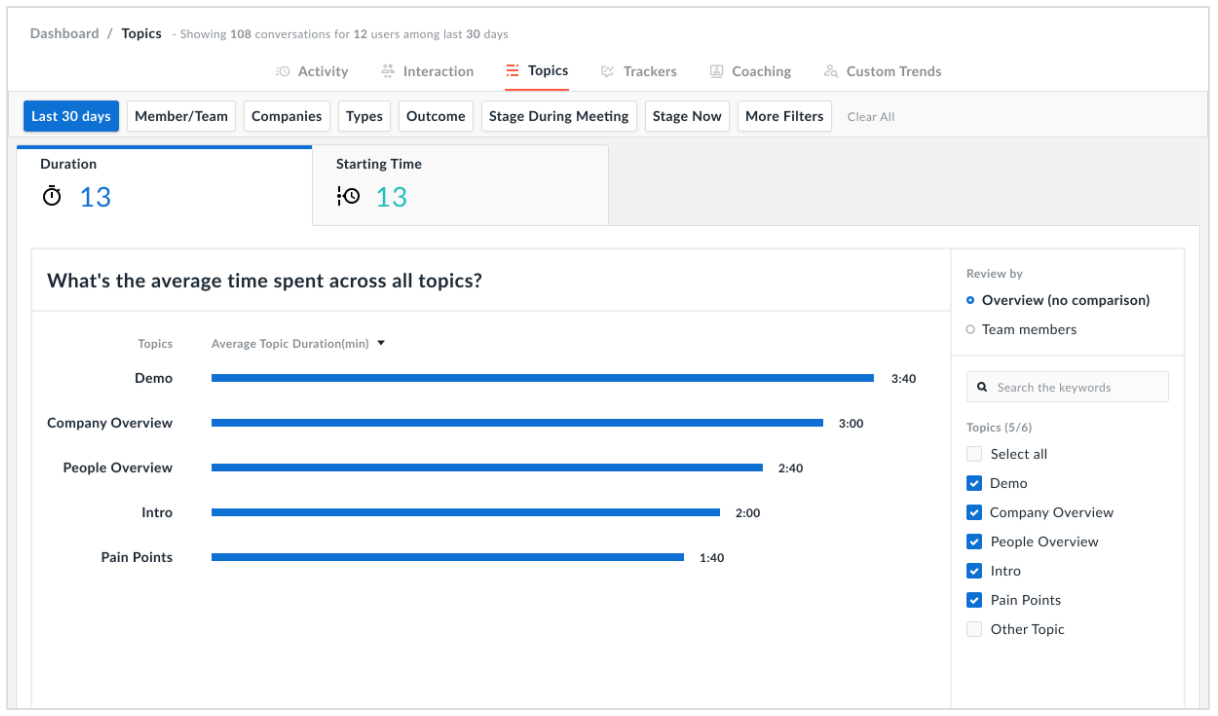
Deal intelligence is another powerful analytics that Meeting Intelligence offers as part of its capability. With deal intelligence, you don’t stop analyzing customer meetings and calls across functions such as marketing or sales. Instead, it gives you a 360° view of all deals in your sales pipeline to help you understand if they are doing well or if sales deals are at risk of slipping through the cracks. In simple words, deal intelligence extends the power of conversation intelligence to enhance your revenue operations.
At a granular level, deal intelligence lets you go deeper into a specific deal to understand the following things:
- Who are the people involved in the deal from your side, as well as the prospect’s organization?
- Who are the key decision-makers engaged?
- What stage is the deal in currently?
- The number of conversations across meetings, calls, emails
- The last contacted/engaged date
The best part about deal intelligence is its capability to democratize deal data across all functions of your organization—and not just the sales or other customer-facing teams.
Run meetings like running a business
Looking back at the opening of this post, Reid is probably right—running a business is certainly about figuring things out as you go. But while it’s a sentiment that underscores the importance of bias to action—it’s not something to be proud of. Running a business also takes a lot of forethought, planning, goal setting, time management, and decision making.
In that sense, running a meeting is a lot like running your business—you need a solid plan, a vision, and tangible outcomes to make sustainable progress.
Without agendas, for example, meetings often turn out to be mental gymnastics deprived of intellectual and actionable outcomes. And without an end-to-end meeting lifecycle assistant, meetings will continue to be fragmented pieces of information instead of being a vehicle of cross functional collaboration.
Frequently Asked Questions






What's stopping you from turning every conversation into actionable insights?



